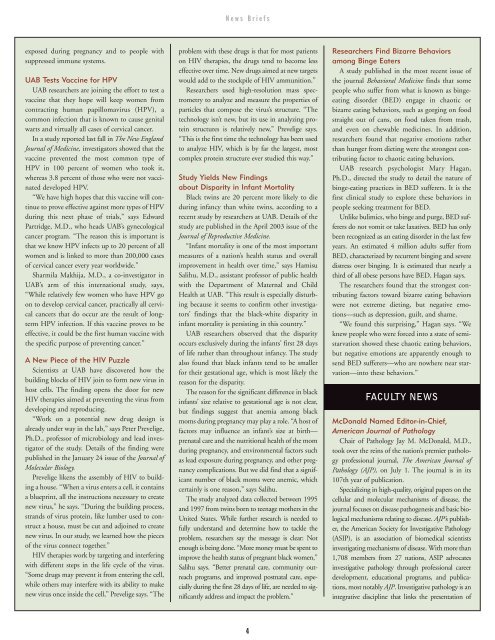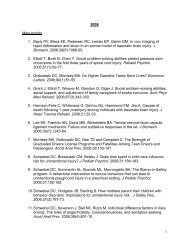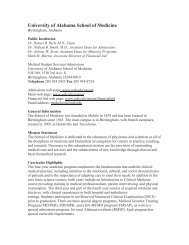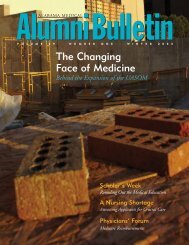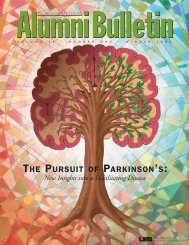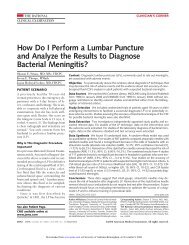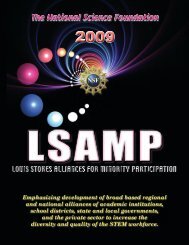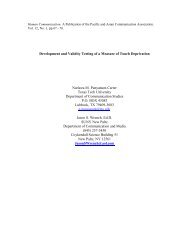AlumniBulletin - The University of Alabama at Birmingham
AlumniBulletin - The University of Alabama at Birmingham
AlumniBulletin - The University of Alabama at Birmingham
You also want an ePaper? Increase the reach of your titles
YUMPU automatically turns print PDFs into web optimized ePapers that Google loves.
News Briefs<br />
exposed during pregnancy and to people with<br />
suppressed immune systems.<br />
UAB Tests Vaccine for HPV<br />
UAB researchers are joining the effort to test a<br />
vaccine th<strong>at</strong> they hope will keep women from<br />
contracting human papillomavirus (HPV), a<br />
common infection th<strong>at</strong> is known to cause genital<br />
warts and virtually all cases <strong>of</strong> cervical cancer.<br />
In a study reported last fall in <strong>The</strong> New England<br />
Journal <strong>of</strong> Medicine, investig<strong>at</strong>ors showed th<strong>at</strong> the<br />
vaccine prevented the most common type <strong>of</strong><br />
HPV in 100 percent <strong>of</strong> women who took it,<br />
whereas 3.8 percent <strong>of</strong> those who were not vaccin<strong>at</strong>ed<br />
developed HPV.<br />
“We have high hopes th<strong>at</strong> this vaccine will continue<br />
to prove effective against more types <strong>of</strong> HPV<br />
during this next phase <strong>of</strong> trials,” says Edward<br />
Partridge, M.D., who heads UAB’s gynecological<br />
cancer program. “<strong>The</strong> reason this is important is<br />
th<strong>at</strong> we know HPV infects up to 20 percent <strong>of</strong> all<br />
women and is linked to more than 200,000 cases<br />
<strong>of</strong> cervical cancer every year worldwide.”<br />
Sharmila Makhija, M.D., a co-investig<strong>at</strong>or in<br />
UAB’s arm <strong>of</strong> this intern<strong>at</strong>ional study, says,<br />
“While rel<strong>at</strong>ively few women who have HPV go<br />
on to develop cervical cancer, practically all cervical<br />
cancers th<strong>at</strong> do occur are the result <strong>of</strong> longterm<br />
HPV infection. If this vaccine proves to be<br />
effective, it could be the first human vaccine with<br />
the specific purpose <strong>of</strong> preventing cancer.”<br />
A New Piece <strong>of</strong> the HIV Puzzle<br />
Scientists <strong>at</strong> UAB have discovered how the<br />
building blocks <strong>of</strong> HIV join to form new virus in<br />
host cells. <strong>The</strong> finding opens the door for new<br />
HIV therapies aimed <strong>at</strong> preventing the virus from<br />
developing and reproducing.<br />
“Work on a potential new drug design is<br />
already under way in the lab,” says Peter Prevelige,<br />
Ph.D., pr<strong>of</strong>essor <strong>of</strong> microbiology and lead investig<strong>at</strong>or<br />
<strong>of</strong> the study. Details <strong>of</strong> the finding were<br />
published in the January 24 issue <strong>of</strong> the Journal <strong>of</strong><br />
Molecular Biology.<br />
Prevelige likens the assembly <strong>of</strong> HIV to building<br />
a house. “When a virus enters a cell, it contains<br />
a blueprint, all the instructions necessary to cre<strong>at</strong>e<br />
new virus,” he says. “During the building process,<br />
strands <strong>of</strong> virus protein, like lumber used to construct<br />
a house, must be cut and adjoined to cre<strong>at</strong>e<br />
new virus. In our study, we learned how the pieces<br />
<strong>of</strong> the virus connect together.”<br />
HIV therapies work by targeting and interfering<br />
with different steps in the life cycle <strong>of</strong> the virus.<br />
“Some drugs may prevent it from entering the cell,<br />
while others may interfere with its ability to make<br />
new virus once inside the cell,” Prevelige says. “<strong>The</strong><br />
problem with these drugs is th<strong>at</strong> for most p<strong>at</strong>ients<br />
on HIV therapies, the drugs tend to become less<br />
effective over time. New drugs aimed <strong>at</strong> new targets<br />
would add to the stockpile <strong>of</strong> HIV ammunition.”<br />
Researchers used high-resolution mass spectrometry<br />
to analyze and measure the properties <strong>of</strong><br />
particles th<strong>at</strong> compose the virus’s structure. “<strong>The</strong><br />
technology isn’t new, but its use in analyzing protein<br />
structures is rel<strong>at</strong>ively new,” Prevelige says.<br />
“This is the first time the technology has been used<br />
to analyze HIV, which is by far the largest, most<br />
complex protein structure ever studied this way.”<br />
Study Yields New Findings<br />
about Disparity in Infant Mortality<br />
Black twins are 20 percent more likely to die<br />
during infancy than white twins, according to a<br />
recent study by researchers <strong>at</strong> UAB. Details <strong>of</strong> the<br />
study are published in the April 2003 issue <strong>of</strong> the<br />
Journal <strong>of</strong> Reproductive Medicine.<br />
“Infant mortality is one <strong>of</strong> the most important<br />
measures <strong>of</strong> a n<strong>at</strong>ion’s health st<strong>at</strong>us and overall<br />
improvement in health over time,” says Hamisu<br />
Salihu, M.D., assistant pr<strong>of</strong>essor <strong>of</strong> public health<br />
with the Department <strong>of</strong> M<strong>at</strong>ernal and Child<br />
Health <strong>at</strong> UAB. “This result is especially disturbing<br />
because it seems to confirm other investig<strong>at</strong>ors’<br />
findings th<strong>at</strong> the black-white disparity in<br />
infant mortality is persisting in this country.”<br />
UAB researchers observed th<strong>at</strong> the disparity<br />
occurs exclusively during the infants’ first 28 days<br />
<strong>of</strong> life r<strong>at</strong>her than throughout infancy. <strong>The</strong> study<br />
also found th<strong>at</strong> black infants tend to be smaller<br />
for their gest<strong>at</strong>ional age, which is most likely the<br />
reason for the disparity.<br />
<strong>The</strong> reason for the significant difference in black<br />
infants’ size rel<strong>at</strong>ive to gest<strong>at</strong>ional age is not clear,<br />
but findings suggest th<strong>at</strong> anemia among black<br />
moms during pregnancy may play a role. “A host <strong>of</strong><br />
factors may influence an infant’s size <strong>at</strong> birth—<br />
pren<strong>at</strong>al care and the nutritional health <strong>of</strong> the mom<br />
during pregnancy, and environmental factors such<br />
as lead exposure during pregnancy, and other pregnancy<br />
complic<strong>at</strong>ions. But we did find th<strong>at</strong> a significant<br />
number <strong>of</strong> black moms were anemic, which<br />
certainly is one reason,” says Salihu.<br />
<strong>The</strong> study analyzed d<strong>at</strong>a collected between 1995<br />
and 1997 from twins born to teenage mothers in the<br />
United St<strong>at</strong>es. While further research is needed to<br />
fully understand and determine how to tackle the<br />
problem, researchers say the message is clear: Not<br />
enough is being done. “More money must be spent to<br />
improve the health st<strong>at</strong>us <strong>of</strong> pregnant black women,”<br />
Salihu says. “Better pren<strong>at</strong>al care, community outreach<br />
programs, and improved postn<strong>at</strong>al care, especially<br />
during the first 28 days <strong>of</strong> life, are needed to significantly<br />
address and impact the problem.”<br />
Researchers Find Bizarre Behaviors<br />
among Binge E<strong>at</strong>ers<br />
A study published in the most recent issue <strong>of</strong><br />
the journal Behavioral Medicine finds th<strong>at</strong> some<br />
people who suffer from wh<strong>at</strong> is known as bingee<strong>at</strong>ing<br />
disorder (BED) engage in chaotic or<br />
bizarre e<strong>at</strong>ing behaviors, such as gorging on food<br />
straight out <strong>of</strong> cans, on food taken from trash,<br />
and even on chewable medicines. In addition,<br />
researchers found th<strong>at</strong> neg<strong>at</strong>ive emotions r<strong>at</strong>her<br />
than hunger from dieting were the strongest contributing<br />
factor to chaotic e<strong>at</strong>ing behaviors.<br />
UAB research psychologist Mary Hagan,<br />
Ph.D., directed the study to detail the n<strong>at</strong>ure <strong>of</strong><br />
binge-e<strong>at</strong>ing practices in BED sufferers. It is the<br />
first clinical study to explore these behaviors in<br />
people seeking tre<strong>at</strong>ment for BED.<br />
Unlike bulimics, who binge and purge, BED sufferers<br />
do not vomit or take lax<strong>at</strong>ives. BED has only<br />
been recognized as an e<strong>at</strong>ing disorder in the last few<br />
years. An estim<strong>at</strong>ed 4 million adults suffer from<br />
BED, characterized by recurrent binging and severe<br />
distress over binging. It is estim<strong>at</strong>ed th<strong>at</strong> nearly a<br />
third <strong>of</strong> all obese persons have BED, Hagan says.<br />
<strong>The</strong> researchers found th<strong>at</strong> the strongest contributing<br />
factors toward bizarre e<strong>at</strong>ing behaviors<br />
were not extreme dieting, but neg<strong>at</strong>ive emotions—such<br />
as depression, guilt, and shame.<br />
“We found this surprising,” Hagan says. “We<br />
knew people who were forced into a st<strong>at</strong>e <strong>of</strong> semistarv<strong>at</strong>ion<br />
showed these chaotic e<strong>at</strong>ing behaviors,<br />
but neg<strong>at</strong>ive emotions are apparently enough to<br />
send BED sufferers—who are nowhere near starv<strong>at</strong>ion—into<br />
these behaviors.”<br />
FACULTY NEWS<br />
McDonald Named Editor-in-Chief,<br />
American Journal <strong>of</strong> P<strong>at</strong>hology<br />
Chair <strong>of</strong> P<strong>at</strong>hology Jay M. McDonald, M.D.,<br />
took over the reins <strong>of</strong> the n<strong>at</strong>ion’s premier p<strong>at</strong>hology<br />
pr<strong>of</strong>essional journal, <strong>The</strong> American Journal <strong>of</strong><br />
P<strong>at</strong>hology (AJP), on July 1. <strong>The</strong> journal is in its<br />
107th year <strong>of</strong> public<strong>at</strong>ion.<br />
Specializing in high-quality, original papers on the<br />
cellular and molecular mechanisms <strong>of</strong> disease, the<br />
journal focuses on disease p<strong>at</strong>hogenesis and basic biological<br />
mechanisms rel<strong>at</strong>ing to disease. AJP’s publisher,<br />
the American Society for Investig<strong>at</strong>ive P<strong>at</strong>hology<br />
(ASIP), is an associ<strong>at</strong>ion <strong>of</strong> biomedical scientists<br />
investig<strong>at</strong>ing mechanisms <strong>of</strong> disease. With more than<br />
1,708 members from 27 n<strong>at</strong>ions, ASIP advoc<strong>at</strong>es<br />
investig<strong>at</strong>ive p<strong>at</strong>hology through pr<strong>of</strong>essional career<br />
development, educ<strong>at</strong>ional programs, and public<strong>at</strong>ions,<br />
most notably AJP. Investig<strong>at</strong>ive p<strong>at</strong>hology is an<br />
integr<strong>at</strong>ive discipline th<strong>at</strong> links the present<strong>at</strong>ion <strong>of</strong><br />
4


